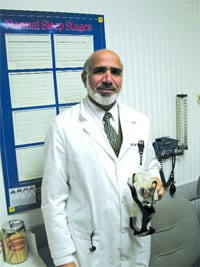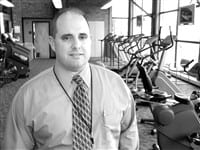Down Time As Awareness of Sleep Disorders Goes Mainstream, Sufferers See Their Dreams Come True
Dr. Jay Fleitman tells the story of a patient with sleep apnea who fell asleep one day behind the wheel. Almost immediately, his car crossed the dividing line of the road and struck another car head-on, jolting him awake. Fortunately, both drivers walked away from the accident.
But in the instant of the collision, the man dreamed that he’d walked into a door — his mind’s way of processing the accident. Why is that strange? Because for most people, it takes about 90 minutes to reach the rapid-eye-movement, or REM, level of sleep, during which dreams occur. The shorter the time between falling asleep and dreaming, the more sleep-deprived a person is.
This was clearly one sleep-deprived individual, said Fleitman, a Northampton-based pulmonologist. And he’s not alone. According to the National Institutes of Health, sleeplessness creates $16 billion in health care expenses and $50 billion in lost productivity annually.
In addition, sleep deprivation has been compared to alcohol intoxication in its effects on motorists, causing an estimated 100,000 motor vehicle accidents in the U.S. each year and killing 1,500, according to the National Highway Traffic Safety Administration. Meanwhile, lack of proper sleep can compromise safety on jobs where heavy machinery is involved.
At the center of all this, for millions of Americans, is a condition known as sleep apnea, which repeatedly closes the sufferer’s airways throughout the night and keeps him or her from achieving uninterrupted, restful sleep. Apnea was first diagnosed in the early 1980s, but awareness has grown in recent years, due partly to newly discovered connections between sleep apnea and other health problems.
This increasing awareness has in turn spawned a boom in the business of sleep. Back in the 1970s, before sleep apnea had been identified, only a few sleep labs existed in the U.S. Now there are close to 700, with more opening their doors every month.
As awareness of sleep apnea has increased, so has the market for the diagnosis and treatment of the condition.
“It’s a monster market,” Peter Farrell, CEO of California-based ResMed, told Wired magazine recently. And why not? Last year, his company sold $465 million worth of equipment designed to treat sleep disorders.
This month, The Healthcare News examines a problem that continues to make a good night’s rest a mere pipe dream for many Americans — and looks at what doctors and researchers are doing to help sufferers get the rest they need.
Gasping for Air
Depending on whom one asks, sleep apnea affects somewhere between 4{06cf2b9696b159f874511d23dbc893eb1ac83014175ed30550cfff22781411e5} and 6{06cf2b9696b159f874511d23dbc893eb1ac83014175ed30550cfff22781411e5} of Americans, but men are twice as prone to it as women, and it’s more commonly diagnosed in middle age.
The physiology of apnea is simple. In those who suffer from the condition, the muscles that keep the throat open relax during sleep, to the point where the throat closes, so that airflow is eliminated or markedly reduced, Fleitman explained. When that happens, the oxygen level in the blood starts to drop, and that arouses the person from sleep.
It’s a pattern that repeats regularly — in the most severe cases, hundreds of times per night — and doesn’t allow the sufferer to spend the needed amount of time in REM sleep, which the body needs to achieve proper rest. “Their sleep is fragmented,” Fleitman said, “and when they wake up in the morning, they feel as if they’ve had not much sleep at all.”
Aside from feeling sleepy during the day, a person often has little indication that he or she has sleep apnea, particularly if they’re not aware of the condition, said Dr. Mohammad Bajwa, a Holyoke-based physician who focuses on internal medicine and chest diseases.
“The person who suffers from it wouldn’t know about the respiratory pauses,” he said, “so often, their partner is the one who picks up on it. And if it’s not picked up early, it could lead to some serious consequences, like an accident at work or an accident while driving.
“The important thing is, it impairs the quality and quantity of sleep, and that leads to a sleep-deprivation condition that accumulates,” he continued. “That results in a defect in mental cognitive powers and functional capacity.”
However, studies in recent years have shown even more serious effects from sleep apnea. Even if someone with the condition manages to avoid accidents and navigate poor job performance, doctors have linked sleep apnea with higher incidences of high blood pressure and other chronic conditions.
“We’re finding now that if sleep apnea is not treated, it can aggravate heart conditions and neurological conditions,” Bajwa said. “People who have it have a higher tendency toward strokes, and it makes it more difficult to control diseases like hypertension and diabetes. As the research is going on, we’re finding more and more medical problems that are aggravated by sleep apnea, and that’s why there’s so much emphasis on diagnosing and treating it.”
There is a silver lining to the connection between apnea and other diseases, however, Fleitman noted. “If someone needs multiple drugs to control high blood pressure, sometimes the first symptom we’d look to correct is sleep apnea,” he said. “The high blood pressure often resolves itself with that treatment.”
Masking the Problem
Bajwa said neurological and behavioral conditions — from depression in adults to emotional outbursts and poor school performance in children — can also see similar improvement by treating an underlying sleep disorder.
“Your quality of life is poor, your mental status is poor, your judgment is poor,” he said, “and it’s basically because of this poor oxygenation of the tissues.”
The mainstay treatment, Bajwa noted, is a device called CPAP, which stands for continuous positive airway pressure. It uses a mask over the face or nose which blows air into the mouth and throat, keeping the airways open during sleep. Despite the many advances in medical technology over the past 20 years, Fleitman said, doctors who first treated sleep apnea got it right early on.
“I finished my training in 1984, around the time when sleep apnea was first described as a clinical syndrome,” he said. “The CPAP was devised around 1984 or 1985, and though the equipment is better now, the fundamental process of treatment is not much different.”
Doctors still consider the CPAP the easiest way to effectively control sleep apnea. And while the device requires patience from most users, a good number — around 25{06cf2b9696b159f874511d23dbc893eb1ac83014175ed30550cfff22781411e5} to 30{06cf2b9696b159f874511d23dbc893eb1ac83014175ed30550cfff22781411e5}, Fleitman said — never stop struggling to accommodate the mask. That’s where alternative therapies come in, such as an oral appliance resembling a mouth guard that fits on the teeth and pulls the lower jaw forward to tighten the throat muscles.
Surgeries are also sometimes recommended. One common procedure removes the uvula, tonsils, and part of the soft palate, but it works only about 50{06cf2b9696b159f874511d23dbc893eb1ac83014175ed30550cfff22781411e5} of the time, Fleitman said.
In rare, extreme cases, a tracheostomy is available that basically creates a permanent hole in the throat. During the day, the hole is blocked and the patient breathes normally, but at night, it is opened, allowing breathing to bypass the throat muscles.
That definitely works, he said, “but it’s disfiguring and completely unacceptable to most people. It’s better to try to make the CPAP work. That’s the best therapy, and with some patience, you can make the mask work for most people.”
And devices such as the CPAP are, in fact, gaining popularity. In a survey last year, HomeCare magazine, a trade publication for the medical equipment industry, found that the respiratory and sleep market is clearly on the rise, with most of the 266 home medical equipment companies in the survey reporting that they will expand further into sleep-related products.
Respiratory products already account for an average of 46{06cf2b9696b159f874511d23dbc893eb1ac83014175ed30550cfff22781411e5} of the companies’ business, with median annual revenue of $2.8 million. Products specifically related to sleep disorders, particularly apnea, account for 17{06cf2b9696b159f874511d23dbc893eb1ac83014175ed30550cfff22781411e5} of respondents’ revenue, with 84{06cf2b9696b159f874511d23dbc893eb1ac83014175ed30550cfff22781411e5} offering CPAP. Meanwhile, 75{06cf2b9696b159f874511d23dbc893eb1ac83014175ed30550cfff22781411e5} of the companies expect revenues from such products to increase in the coming months, with another 15{06cf2b9696b159f874511d23dbc893eb1ac83014175ed30550cfff22781411e5} expecting sales to remain stable.
Also on the rise are sleep labs, facilities where patients spend the night to confirm a diagnosis of sleep apnea or another disorder. Several hospitals in the region, including Holyoke Medical Center and Baystate Medical Center, have labs in-house, while others, such as Cooley Dickinson Hospital and Mercy Medical Center, are affiliated with nearby labs. Fleitman himself will open a lab in Northampton this spring.
At the heart of the sleep study is a test called a polysomnogram (PSG), which tests a variety of bodily functions to come up with a diagnosis. The patient is set up in a room typically meant to resemble a small hotel room and sleeps with a battery of wires taped to his or her body.
“We create a very comfortable environment and have them sleep overnight,” Bajwa said, explaining that the PSG includes wires on the head to measure brainwaves and monitor sleep stages, wires near the eyes to measure eye movements, devices around the nose and mouth to measure airflow, electrodes on the chest to measure breathing, and wires on the legs to determine whether the patient suffers from something called restless leg syndrome, another sleep disorder. Heart rate, oxygen levels, and other vital signs are also tracked.
“A technician sits in another room and watches the person on video,” Bajwa said, while a computer tracks all the information and displays it in 30-second increments. “It tells us what kind of sleep he had, how many times he stopped breathing, and what happened to the oxygen level. Then we put that all together to diagnose whether somebody has sleep apnea.”
Changing Lives
For many people, Bajwa asserted, the best treatment is weight loss, as obesity is widely recognized as a key trigger for the condition. Beyond that, however, patients are discovering an ever-widening palette of options to treat a problem that is fast gaining traction in public perception.
Fleitman told the story of a man in his 50s who had lost jobs, was on his third marriage, and chronically sported a pasty, swollen face — until he had his sleep apnea diagnosed and treated. A short time later, he came into Fleitman’s office and was almost unrecognizable, full of life where there had been no spark before.
“Lives change quite dramatically,” he said. “And I have to wonder — what would this guy’s life have been like had this been identified when he was 17 years old, as opposed to 50? It’s hard to know.”
Increasingly, however, Americans who struggle to sleep and breathe at the same time are finding out.


